A recent 451 Research report surveyed 800+ data center providers worldwide and discovered the majority of respondents (57 percent) view sustainability as a competitive differentiator and cite customer expectations as a major driver. But only 43 percent said they have strategic sustainability initiatives and efficiency improvements in place for their infrastructure.
That means that the majority of data center providers across the globe lack a strategic plan for sustainability at a time when customers are demanding it and regulations may soon require it.
I recently had the pleasure of speaking about sustainability at DCD’s Towards Net-Zero event and my resounding message was to organize and prioritize around data center sustainability. It’s a big undertaking but it’s one that we can successfully achieve together. Schneider Electric addresses this challenge with a five-pronged framework.
When it comes to sustainability, there’s no Plan B
My presentation, When There’s no Plan B, A Framework for Achieving Sustainability in Data Centers, dove deep into the framework that will help your company move in the right direction. Of course, I encourage you to watch the full presentation to learn much more but here are the highlights:
1. Set a bold and actionable strategy – Everything starts with a strategy. Create one with clear objectives and prioritized action. You must align internal expertise and resources by having the teams for design, procurement, facility operations, and sustainability all working together.
Then, make a business case to justify and fund projects, which will require executive sponsorship and leadership… and most likely a strategy for placing a value on carbon whether through carbon pricing or caps on CO2 emissions.
2. Implement efficient designs – As an industry, we have eliminated 80 percent of energy losses with our data center designs, but we are hitting the point of diminishing returns. We must invest in technologies that improve energy efficiency and lower carbon footprint like SF6-Free switchgear and liquid cooling, which could reduce overall IT and infrastructure energy consumption by 15 percent.
And we also must prioritize circular design by designing for reduced size and weight, serviceability, and second life, which translates to fewer raw materials, less land use, lower transportation emissions, etc.
3. Drive operational efficiency – When it comes to operations, they must be efficient and sustainable, and we have done a lot of work in this area. There are connected systems to collect data to provide visibility, track energy usage, and benchmark performance. Predictive maintenance services help drive operational efficiency and reliability while maximizing lifespan through connected services.
Software and analytics are used to monitor and report through dashboards, to help make informed decisions and track sustainability progress. Also, we need to start implementing resource dashboards to track carbon footprint. After all, you can’t manage what you don’t measure.
4. Buy renewable energy – You can accomplish this in three main ways – credit, on-site build, and off-site build. Energy attribute certificates or renewable energy credits are a simple and immediate way to offset your carbon footprint and support clean energy. For onsite/distributed generation, you can install renewable energy sources like solar panels on-premise.
The site can consume the clean energy that it’s generated, or you can connect to the grid. Offsite generation is primarily for longer-term contracts that fund renewable power projects. Power Purchase Agreements or PPAs are most common.
5. Decarbonize your supply chain – This might be your biggest challenge. Your vendor’s supply chain is a part of your carbon footprint. So, it makes good business sense to use vendors that embrace circular economy with circularity designed into products.
Vendors must be transparent about the sustainability impact of their products and should produce a Product Environmental Profile (PEP) or an Environmental Product Declaration (EPD) with detailed information about the materials, compliance, recyclability, and more. Decarbonizing supply chain is a complex topic, but if a vendor is doing the right things, they will be able to produce the documentation.
Where is your company on its climate journey?
If you’re interested in sustainability in data centers, I encourage you to check out the presentation, When There’s no Plan B, A Framework for Achieving Sustainability in Data Centers. Then, take a cold, hard look at where your company is on its climate journey. Maybe you are leading the way or maybe you are just beginning. Either way, Schneider Electric has demonstrated success in helping companies at all stages of the journey
Wider reading...
-

Sponsored Mission-critical considerations for data center UPS deployments
UPS systems are critical to continuity, so plan as if that is true
-

Modernization, Retrofit & Lifecycle Trends Report
Download this free DCD report, brought to you by our content partner Schneider Electric.
-

Broadcast DCD>Building at Scale | Stream on-demand
How can you continue to deliver on data center construction demand and meet the need for speed?


